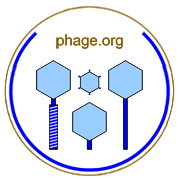

A means of bacterial identification employing panels of individual stocks of whole phages applied to bacterial lawns as spots.
Key to this process is that specific bacterial strains will be sensitive to some phages but not to others that are able to infect (or simply kill) other members of the same bacterial species. In this way a bacterial strain can be described in terms of what phages it is sensitive to, thereby defining a phage type.
Note that a spot is not a plaque but instead is closer in character to a zone of inhibition. Specifically, for phages to spot on a bacterial lawn they must kill those bacteria that they come into contact with. That death can occur both with and without infection (the latter being called lysis from without) and given infection can occur either with or without phage progeny production. If indeed both infection and phage progeny production occur, then a process equivalent to plaque formation can take place, though isolated plaques, as formed by individual phages, will be present only if phage densities applied are low or, alternatively, phage efficiencies of plating are low.
For more on this topic, see Wikipedia, Google, and PubMed. Contact web master. Return to terms.











